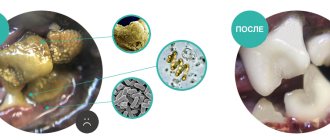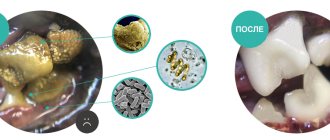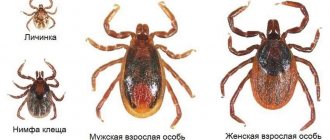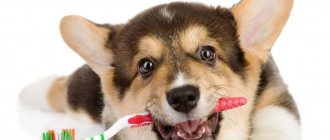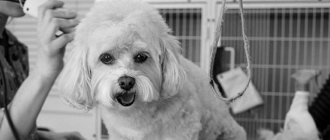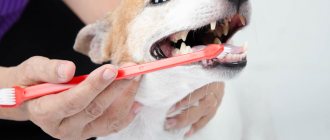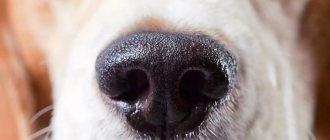Careful oral care is important not only for humans. His four-legged pet also needs regular sanitation of his mouth. Tartar in dogs is a fairly common problem, but it is quite possible to combat it, as well as prevent its occurrence, even at home.
Causes of tartar in dogs
Tartar is a very common disease in domestic dogs. It not only causes pain and inconvenience to the animal, but can lead to the death of the pet.
- Poor nutrition can contribute to rapid tooth decay. Eating only soft food, the dog stops using its teeth the way nature intended.
- The absence of solid food in the diet allows bacteria to run wild at the base of the teeth. Bacteria that feed on the dog's food, which remains on the teeth, leave plaque from their secretions. Plaque is dangerous because it consists of mineralized food residues and salts.
- Irregular teeth structure provides favorable conditions for bacteria to live. Closely spaced, misaligned or crooked teeth are difficult to clean even when the dog eats solid food. Hard-to-reach corners become the site of the highest concentration of bacteria and the development of tartar.
- Increased acidity of saliva is one of the likely reasons that provoke the appearance of growths.
- Lack of concern for hygiene . Brushing your teeth is a mandatory rule of hygiene. Refusal of this ritual leads to oral diseases.
- A sedentary lifestyle leads to impaired water-salt metabolism. Such violations have a bad effect on the condition of the entire body and teeth in particular.
Lack of dental care is one of the reasons for the formation of tartar
Prevention measures
To ensure that your pet’s teeth are always healthy and that you do not have to resort to surgical intervention due to the formation of tartar, it is necessary to regularly monitor your pet’s oral hygiene and carry out preventive measures.
Take care of proper nutrition for your four-legged
Tartar in dogs is partially removed when the animal eats solid food that requires thorough chewing: carrots, apples, cartilage, trachea and bones. But remember that not all bones can be given to your pet. To learn about which bones you can give to your beloved furry friend and which you absolutely cannot, read the article: Can dogs have bones?
Brush your pet's teeth regularly
Regular brushing and special toothpaste for dogs will help keep your pet's teeth healthy for many, many years.
It is not necessary to brush your dog's teeth every day. Preventative cleaning once a week is sufficient. Accustom your little one to this procedure from puppyhood. The sooner he gets used to this, the easier it will be for you to brush his teeth as an adult. Even if your baby hasn’t yet lost his baby teeth, just wrap a bandage around your finger and slowly rub them on your puppy.
Use special products to clean the animal's mouth and freshen its breath.
For example, Oral Clean & Care gels and sprays (trademark “Platinum”) will cope with this task perfectly. They are intended for treating the oral cavity of not only dogs, but also cats, and are made from natural-based ingredients. You can read about this in detail here – https://myplatinum.ru/service/advantages/platinum_zabotitsya_o_polosti_rta_vashego_lyubimtsa/. You can also order online there.
According to a representative of the manufacturer, their hygiene products will not only help eliminate the unpleasant odor emanating from the dog’s mouth. Moreover, it is now possible to remove tartar from your pet without the use of anesthesia, outside the walls of a veterinary clinic! Many questions regarding the use of hygiene sprays and gels will disappear by themselves if you go to this page - https://myplatinum.ru/service/questions/.
In my opinion, the results after using Oral Clean & Care are quite impressive.
How do you like this? In just two weeks.
Excellent result.
Pet stores offer a large selection of special toys for cleaning teeth and massaging gums. Such toys are made of durable rubber or caoutchouc, have small teeth and look like a part of some mechanism.
Be careful to prevent tartar in animals using dry food and various artificial chewing sticks, since not all dogs are suitable for such food, and can often lead to various gastrointestinal diseases: gastritis and constipation.
Preventing tartar formation in dogs is much easier and more effective than treating it. Take care of your four-legged dog’s oral hygiene, and then your fidget’s teeth will always be healthy.
Diagnosis of dental plaque
Looking at the fangs and distant teeth, you can notice the stone even at an early stage of development. The beginning of the formation looks like a yellow plaque at the base of the tooth. This coating is soft and can be easily removed with a dog brush.
With irregular care for oral hygiene, plaque darkens, becomes hard and grows in volume.
Tartar itself does not threaten the life of the animal. But as it develops, bacteria enter the body and can cause serious illness.
Swollen and bleeding gums prevent the animal from eating. Due to the large number of bacteria, sepsis can develop. These consequences can be fatal.
The development of bleeding and sepsis can lead to death
Cleaning Methods
All methods of removing tartar can be divided based on their effect on plaque. There are currently three main options:
- Using ultrasound;
- Mechanical cleaning;
- Dry cleaning.
Ultrasonic cleaning
Is the most effective way. As a result of exposure, the stone is completely removed, tooth enamel is slightly damaged. The procedure is performed in a hospital setting using a specialized apparatus. The impact on dental plaque is carried out by ultrasonic waves. The destruction of the stone and its detachment from the tooth occurs. At the end of the procedure, disinfection is carried out. In some cases, depending on the general condition of the oral cavity (presence of infections), a course of antibiotics may be prescribed.
Ultrasonic cleaning is the least traumatic. It is recommended to carry out once a year.
Mechanical cleaning
Mechanical cleaning is considered a cheaper way to remove stone. It is the physical scraping of plaque using dental instruments (curettes, scalers). It can be recommended at the initial stage of tartar formation for quiet, non-conflict dogs.
Mechanical cleaning is indicated for focal localization of stones on individual teeth.
Removal at home and at the veterinarian
It is better to leave the removal of growths to professionals.
The procedure for cleaning teeth in the hands of a veterinarian is as follows:
- General anesthesia is applied to the dog so that the procedure is painless.
- The doctor performs ultrasonic cleaning of teeth using a special device.
Veterinarians may offer mechanical teeth cleaning, arguing that it will cost less and the effect will be the same as with ultrasound.
However, mechanical cleaning damages tooth enamel, and on a rough surface it is much more convenient for bacteria to rebuild stone. If removed carelessly, the disease will reappear in a short time.
To prevent relapse of the disease, it is better not to skimp on ultrasonic cleaning at the veterinary clinic.
At home, removing tartar from your pet is not only painful for the pet, but also very dangerous. The consequences of inaccurate removal are inflammation of the gums, damage to tooth enamel, and rapid growth of stone again.
You can remove growths yourself only if the disease is in the early stages of development and if the dog behaves calmly at the time of the procedure.
You can clean tartar on your own only in the early stages of the disease.
If the stone has just begun to develop and the dog has a yellowish coating, then a visit to the doctor can be avoided. Brushing with tooth powder with hydrogen peroxide (3%) will help remove plaque.
Pet stores sell many products and medications, as well as a spray, that can help in the early stages of the disease.
How often should you brush your teeth?
Lack of regular oral cleaning brings a lot of trouble to a person and his smaller brothers. Often, teeth disfigured by stone growths cannot be treated. If they cannot be saved, there is only one way out - removal. And, it would seem, just recently the tooth was at a curable stage of caries, and today all that remains is to get rid of it in order to prevent further rotting of the deeper bones. Perhaps it will still be possible to overcome the old plaque, but this will only have to be done within the walls of a medical institution and under general anesthesia, which will bring additional hassle, waste of time and money.
At the same time, there is often no need to devote time to sanitizing the dog’s mouth. Two or three times throughout the year is enough. This will not cause any pain to the animal, and the need for anesthesia will also disappear by itself. The procedure itself lasts no more than half an hour, therefore, spending such a small amount of time, the owner will be rewarded with sparkling and healthy teeth of his pet.
Caring for a sick animal
Prevention against tartar after surgery is mandatory.
Diet when tartar has started or after it has been removed should be made more varied.
The more crunchy vegetables the owner includes in the pet’s diet, the better. Caring for the oral cavity with a special brush should become a habitual procedure for your pet. Getting used to brushing your teeth is not a quick task, but it will help ensure that the disease does not return after the removal surgery.
It is better to treat inflamed gums with special solutions that can be purchased at a pet store.
Nutrition when tartar has begun or after its removal needs to be made more varied.
Symptoms of the disease
The formation of plaque occurs unnoticed - at least if you do not look into the dog's mouth regularly. The thickening of plaque and an increase in its hardness occurs asymptomatically. Only when the disease becomes advanced do the first signs appear. The main symptoms include:
- bad breath;
- the presence of yellowish (at the initial stage) or dark (in more advanced cases) plaque, which is observed at the base of the incisors, canines, and molars;
- gums become inflamed, gingivitis or stomatitis appears;
- in the most severe cases, the gums acquire a loose structure and begin to bleed; The dog often scratches the inflammation areas and refuses food.
Sometimes a severe form of tartar is accompanied by profuse salivation, lethargy, or, on the contrary, increased aggressiveness of the animal.
If the dog begins to slurp unusually while eating, licks itself frequently, and scratches the area around its mouth, it’s time to conduct an initial examination.
Pathogenesis
Precipitated mineral salts are gradually deposited on the yellowish soft coating. Initially loose, the formations harden and darken. The gums swell, bleed, and hurt. It becomes difficult for the dog to grind food with its teeth. Stomatitis, abscesses occur, teeth fall out or require removal.
From the source of inflammation, pathogenic microflora is introduced into the internal organs, causing diseases of the stomach, intestines and kidneys. In severe situations, sepsis develops, ending in the death of the pet.
When is the best time to contact a veterinarian?
Although there are enough products on sale to rid your dog of tartar, in case of large deposits, and also for the first time, it is better to consult a veterinarian. Removing stones on your own risks infection entering the tooth cavity (especially in the presence of a carious process), damage to the gums, and inflammation of the soft tissues and oral cavity. In addition, the animal may suddenly jerk and get injured. And finally, the specialist will not only properly clean your pet’s teeth, but will also carry out sanitation, ensure that the results are consolidated, and give recommendations for further care.
